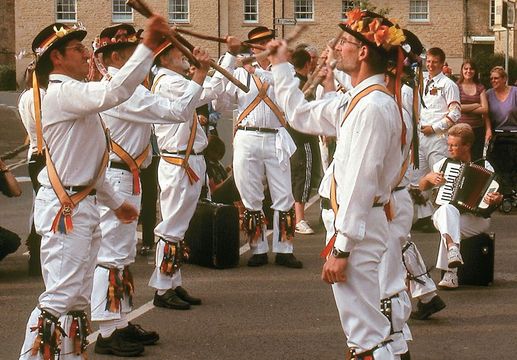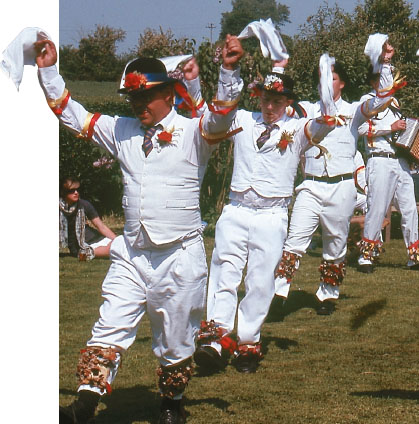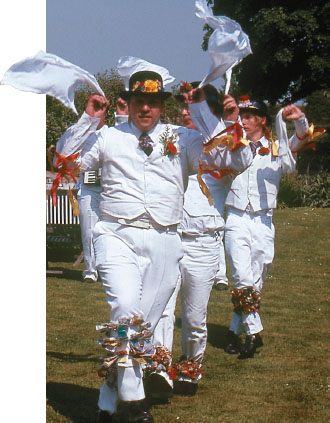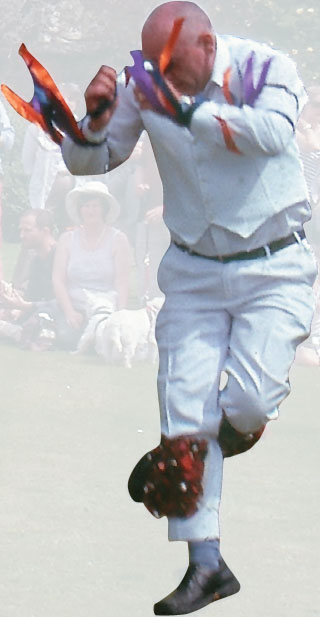
Dating back at least to the 1400s, morris dancing is a uniquely English folk art, danced by “sides” to the music of fiddles and concertinas.
Three things say a man is in England, four things make his location sure: cream teas, roundabouts, pay and display—and Morris dancing on a spring bank holiday.
I had barely finished my full English breakfast when I heard a fiddle launch into “Constant Billy.” Wheelgate House B&B, in Bampton’s ancient marketplace and town center, was ideally situated to observe the first morris dancers of Spring bank holiday.

MELVIN STARR
Sixteen miles southwest of Oxford, Bampton is a village of fewer than 2,000 souls. It is, nevertheless, a center for morris dancing in England. Written records indicate morris dancing has been popular in the town since the late 18th century, and tradition says dancers have performed there on Whit Monday as far back as the 16th century. On May Bank Holiday, three teams, or “sides,” would dance throughout the village, and be joined in the late afternoon by visiting sides from Eynsham and Abingdon.
As with many English traditions—and morris dancing is English, not British; the Scots never took it up—no one knows when or why morris dancing began. Some claim it to be an ancient druid fertility rite, but these are the same folk who claim any English custom or relic from the distant past to be druidic in origin.

MELVIN STARR
The earliest English mention of “morys” dancing comes in the late 15th century, in a court setting, with both men and women participating. Shakespeare mentioned morris dancing in several works, and his actor-friend Will Kempe was a “morrice dauncer.” Some sources claim that the term was original “Moorish” dancing, and came to England from the Iberian Peninsula. Morris dancing’s origins may be in doubt; the fun is not.
Morris dancers from different towns wear distinctive costumes and dance to slightly different steps, but some aspects of the dance and dancers are similar. Traditionally, only men are morris dancers. But, as with other sacred traditions, this custom is breaking down. There are scattered about England a few female sides, and a handful of mixed teams.
Dancers wear white shirts and trousers, and decorate sleeves, trousers, and hats with ribbons and flowers, according to local custom. Circlets of bells go around the legs, just below the knee. Hats of silk or beaver complete the costume. Most dances are performed by a group of six to 10, but they're also are dances done by one or two participants only. The pipe dance, where clay pipes are laid in an “X” before the musician, and the dancer capers about them, is such a dance.
If You’re in Town
 4
4
MELVIN STARR

MELVIN STARR
If you ever find yourself near Oxford in late May, pay a visit to Bampton on the Spring Bank Holiday. Hundreds of spectators crowd Bampton then to enjoy the morris dancing spectacle. The town welcomes all, there is plenty of parking—none of it pay and display! There is also an inexpensive bus service from Oxford. When hunger calls and a break is needed, the town offers several pubs: The Talbot, The Morris Clown, The Horseshoe, and The Romany, and a sandwich shop on the marketplace at the town center.
One member of each side is identified as the clown, and his garb will differ from the others. Sometimes called the “squire,” he carries a staff with an inflated pig’s bladder attached to one end, and a calf’s tail fixed to the other. With this tool, he “belabors the bystanders,” and occasionally delivers a swat across the rump of a dancer with the pig bladder to encourage greater exertion.
Another participant is sword-bearer. This fellow carries a cake, in a round tin, impaled on a vertical sword. Both sword and cake are decorated with ribbons and flowers. A portion of the cake is given to any bystander who contributes to the “squire’s treasury.” Possessing a fragment of cake is said to bring good luck for the coming year, and for the female buyer, fertility.
Centuries ago dancers cavorted to tunes from “whittle and dub”—pipe and tabor. Today they prance to the music of fiddles and concertinas. On this spring morning, one Bampton side honored Reg Hall, who had played the fiddle for that side for 50 years.
Morris dancing nearly died out in the late 19th century. Folklorist Cecil Sharp then published material in the early 20th century that led to a revival of morris dancing. Sharp reported that the most vibrant sides he found a century ago were in Bampton, Oxfordshire.
Morris dancing in Bampton has continued nearly unabated for the past century. Only in 1917 and 1918, during World War I, was the tradition suspended. Even during WWII dancing continued. On Whit Monday, 1941, Bampton’s morris dancers raised £14 toward the purchase of a Spitfire for Britain’s aerial defense. In 2009 the dancers who performed in the marketplace did so beneath a war memorial newly strewn with flowers to honor a town youth killed only weeks before while serving with the British military in Afghanistan.
One Bampton side dedicated this year’s dancing to former dancer and squire Francis Shergold. Shergold joined the side in 1935, was squire from 1949 to 1995, and honorary president from 1995 to the time of his death in November 2008.
Shergold found it difficult to continue Bampton’s morris dancing tradition following WWII. Village rivalries had led to the formation of a breakaway side, and by 1959 his side, the Bampton Traditional Morris Dancers, was down to four dancers.
Shergold was unwilling to allow the village tradition to die, however, and by the time he retired as the squire, in 1995, his side had nearly two dozen dancers. The second folk revival of the 20th century in the 1960s spurred a renewed interest in morris dancing. Two other sides in Bampton, the Traditional Bampton Morris Dancers and the Bampton Morrismen each have another dozen or more dancers.
Although dancing practice continues all year, the focus of Bampton morris dancing is on Spring Bank Holiday Monday. Dancing was formerly performed on Whit Monday, the day after Whitsunday, Pentecost, seven weeks after Easter. The change to the bank holiday was made in the 1970s, and the new date often coincides with the traditional day.
Training for Spring Bank Holiday dancing gets serious immediately after Easter: it had better. Dancing began this year at 8:30 a.m. and continued all day, concluding at dusk, and was then followed by music, singing, and partying in the Talbot Hotel. A lad had better be in good physical condition to adhere to that regimen.
Dancing takes place throughout the day in a variety of locations; in the old town marketplace, in spacious gardens of private homes and in the street before pubs. The Bampton Traditional Morris dancers performed at 28 locations, taking time out only for lunch and tea. The Traditional Bampton Morris Dancers performed at 14 venues, and the Bampton Morrismen danced at 20 locations throughout the village.
Morris dancing may be an ancient custom, steeped in tradition, but the participants are often young. Men with gray and thinning hair are joined by teens, who participate in the festivities with as much enthusiasm as their fathers. Children who are learning the steps are often allowed to join in a dance or two. These rookies can be identified by their black trousers. The oldest dancer this year was Roy Shergold, age 82, who joined one dance “for old time’s sake.”
Roy began dancing with the Bampton Traditional Morris Dancers at age 14. I spoke to a woman spectator whose father had been a dancer, whose husband was cavorting this day, and whose son was a black-trousered beginner, maintaining the tradition for another generation. There’ll always be an England!
* Originally published in 2010.





Comments